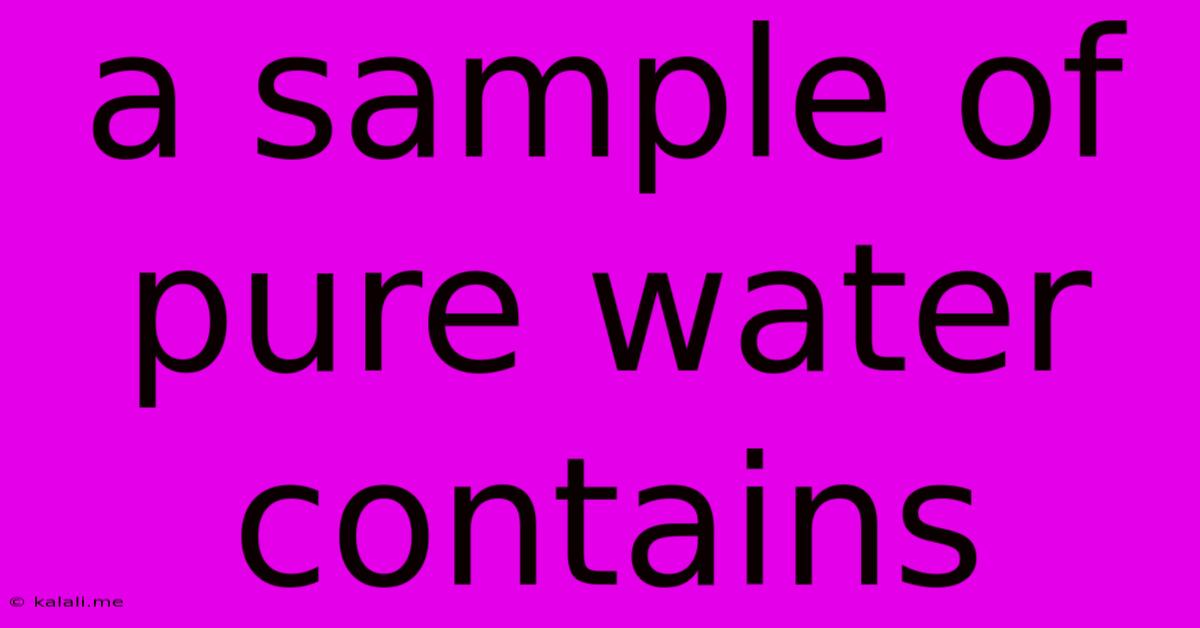A Sample Of Pure Water Contains
Kalali
Jun 14, 2025 · 3 min read

Table of Contents
A Sample of Pure Water Contains: More Than You Think!
A seemingly simple question, "What does a sample of pure water contain?", reveals a surprisingly complex answer. While the layman might immediately answer "H₂O," the reality is far richer, encompassing not just the water molecule itself but also a multitude of trace elements and properties that define its character. This article delves into the fascinating composition of pure water, examining its molecular structure and the subtle influences that shape its properties.
Understanding the Basics: H₂O and Beyond
At its core, pure water is composed of water molecules (H₂O). Each molecule consists of two hydrogen atoms covalently bonded to a single oxygen atom. This seemingly simple structure gives rise to the remarkable properties of water, including its high surface tension, high specific heat capacity, and its ability to act as a universal solvent. However, even the purest water sample contains more than just H₂O molecules.
Trace Elements and Dissolved Gases:
Even in the most meticulously purified water, trace amounts of various elements and dissolved gases are present. These can include:
- Dissolved Gases: Oxygen (O₂), nitrogen (N₂), carbon dioxide (CO₂), and other atmospheric gases can dissolve into water, influencing its pH and chemical reactivity. The amount of dissolved gas varies depending on factors like temperature and atmospheric pressure. This is why bottled water often lists dissolved oxygen as part of its composition.
- Minerals and Ions: While pure water is characterized by the absence of significant mineral content, extremely minute quantities of minerals and ions can still exist. These often originate from the container or the purification process itself. These can include trace amounts of sodium (Na⁺), potassium (K⁺), calcium (Ca²⁺), magnesium (Mg²⁺), chloride (Cl⁻), and sulfate (SO₄²⁻) ions, among others.
- Isotopes: Water molecules exist in various isotopic forms. While the most common form consists of two ¹H (protium) atoms and one ¹⁶O atom, isotopes like deuterium (²H) and tritium (³H) and different oxygen isotopes can also be found in water, though in much smaller quantities. The proportions of these isotopes can vary slightly depending on the source of the water.
The Influence of Purity Levels:
The exact composition of a water sample strongly depends on its purity level. Different purification techniques, such as distillation, deionization, and reverse osmosis, remove varying amounts of impurities. Highly purified water, such as that used in scientific laboratories, will have a significantly lower concentration of dissolved gases, minerals, and ions compared to tap water or even bottled water.
Measuring Purity: Conductivity and pH
The purity of water is often assessed using parameters like electrical conductivity and pH. Highly pure water has very low conductivity due to the limited number of ions present. Similarly, the pH of pure water is close to neutral (around 7), although atmospheric CO₂ can slightly lower this value.
In Conclusion:
While the chemical formula H₂O accurately represents the fundamental building block of water, a true picture of pure water's composition must consider its trace elements and other properties. Understanding this complexity is crucial in various fields, from scientific research to industrial processes, emphasizing the need for precise water quality control and analysis in a multitude of applications. The seemingly simple concept of pure water contains a wealth of subtle details deserving a deeper exploration.
Latest Posts
Latest Posts
-
What Is The Correct Order Of Piagets Stages Of Development
Jun 15, 2025
-
Herzbergs Motivational Factors Are Similar To Maslows
Jun 15, 2025
-
The Radius Of A Sphere Is 6 Units
Jun 15, 2025
-
Sare Jahan Se Acha Who Wrote
Jun 15, 2025
-
Non Metal That Is A Liquid At Room Temperature
Jun 15, 2025
Related Post
Thank you for visiting our website which covers about A Sample Of Pure Water Contains . We hope the information provided has been useful to you. Feel free to contact us if you have any questions or need further assistance. See you next time and don't miss to bookmark.